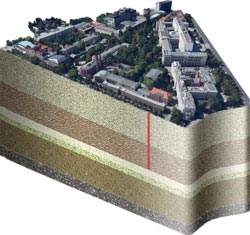Research on seasonal thermal storage in the underground

Schematische Darstellung der Erkundungsbohrung unter dem TU Campus Charlottenburg (Abbildung: Guido Blöcher, GFZ, unter Verwendung von Google Earth)
GFZ German Research Centre begins exploratory drilling on the TU Berlin campus.
Today the GFZ German Research Centre for Geosciences starts off the research drilling on the campus of the TU Berlin in Charlottenburg.
The research well will deliver data for the scientific evaluation of the suitability of the Berlin subsurface as a thermal and cold reservoir. The drilling will be accompanied by extensive borehole measurements and laboratory investigations.
Porous, aquiferous rock layers, so-called aquifers offer a high potential for the seasonal storage of heat or cold. For example in summer heat can be stored in deep rock layers, which can then be used for a thermal supply in winter.
Ernst Huenges, Head of geothermal research at the GFZ and Professor at the TU Berlin explains: “Currently, Berlin’s heat supply is almost completely based on fossil fuel. The seasonal thermal storage in the subsurface has great potential with regard to providing a metropolis such as Berlin with it own domestic heat supply.”
Ali Saadat, Head of the project added “When we consider a future energy supply for urban quarters such as, for example, the TU Campus Berlin, aquifer storage facilities are simply indispensable. With reliable application concepts we will be able to substantially contribute to the further development of this environmental friendly technology.”
To date only very little data from the underground in Berlin is available. The results obtained from the actual drilling and the accompanying investigations in the field and in the laboratory will substantially increase the geological understanding on the structure of the deeper underground in Berlin.
The exploration well will be drilled as a vertical drilling to a depth of approx. 530 metres, i.e. significantly below the drinking water layer.
For scientific investigations, rock samples and drill cores of up to 100 metres in length will be taken for examination on-site as well as in the laboratories of the GFZ.
This drilling is part of a joint research project between the GFZ German Research Centre for Geosciences, the Technische Universität Berlin and the Universität der Künste Berlin. Within the framework of this project know-how from the different disciplines such as energy technology geochemistry and geology, architecture and urban development will be brought together in order to develop seasonal storage concepts for the thermal supply of urban quarters and building complexes.
Already since the year 2000 seasonal thermal and cold reservoirs underneath the “Platz der Republik” are supplying the parliament buildings in Berlin with energy.
Please visit
http://www.gfz-potsdam.de/ates
for further information on the drilling project and its current status.
Pictures are at: http://www.gfz-potsdam.de/medien-kommunikation/mediathek/bildarchiv/geothermie/t…
The project is funded by the Federal Ministry of Economics.
Media Contact
All latest news from the category: Earth Sciences
Earth Sciences (also referred to as Geosciences), which deals with basic issues surrounding our planet, plays a vital role in the area of energy and raw materials supply.
Earth Sciences comprises subjects such as geology, geography, geological informatics, paleontology, mineralogy, petrography, crystallography, geophysics, geodesy, glaciology, cartography, photogrammetry, meteorology and seismology, early-warning systems, earthquake research and polar research.
Newest articles

Silicon Carbide Innovation Alliance to drive industrial-scale semiconductor work
Known for its ability to withstand extreme environments and high voltages, silicon carbide (SiC) is a semiconducting material made up of silicon and carbon atoms arranged into crystals that is…

New SPECT/CT technique shows impressive biomarker identification
…offers increased access for prostate cancer patients. A novel SPECT/CT acquisition method can accurately detect radiopharmaceutical biodistribution in a convenient manner for prostate cancer patients, opening the door for more…

How 3D printers can give robots a soft touch
Soft skin coverings and touch sensors have emerged as a promising feature for robots that are both safer and more intuitive for human interaction, but they are expensive and difficult…




















